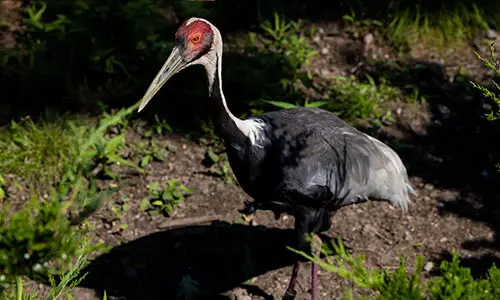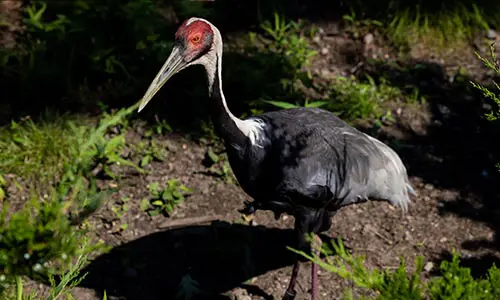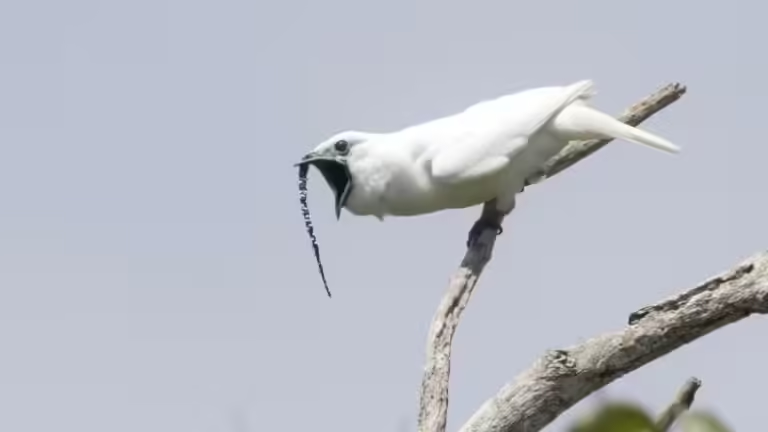As you’re scanning the wetlands of East Asia, you spot a majestic bird with a striking red crown and white hindneck – could it be a White Naped Crane? This iconic species is often mistaken for its cousins, but its unique combination of physical characteristics sets it apart. You notice the bird’s moderately long beak, broad wings, and sturdy legs, but you’re not entirely convinced. What other key features should you look for to confirm its identity, and how do these characteristics differ from those of similar species?
Key Takeaways
- The White Naped Crane’s distinctive plumage features a white forehead, grey crown, and white nape, setting it apart from similar species.
- The shape of the crown and crest is diagnostic, with a distinctive drooping appearance that distinguishes it from other cranes.
- The leg and foot color, which is pinkish-red, provides another key identification feature that differs from other crane species.
- The overall plumage is predominantly grey, with a subtle sheen that catches the light, and a darker, slate-grey color on the wings and back.
- The crest shape, comprising long, pointed feathers, is crucial for identification and distinguishes the White Naped Crane from other crane species.
Physical Characteristics
Three distinctive characteristics set the White-naped Crane apart from other crane species: its white hindneck and upper back, black neck and breast, and a red crown. These color patterns are crucial for identifying the species, but you’ll also want to examine its physical characteristics more closely.
The White-naped Crane’s beak, for instance, is moderately long and strong, perfect for foraging in wetlands and grasping small prey. Its beak strength is remarkable, allowing it to exert a significant amount of pressure when needed.
The crane’s plumage is another key aspect of its physical characteristics. The feathers have a soft, fluffy texture, which helps to insulate the bird in cold temperatures.
The wings are long and broad, with a wingspan reaching up to 2 meters, allowing the crane to cover great distances with ease. The legs and feet are long and sturdy, well-adapted for wading in shallow water. By examining these physical characteristics, you’ll be well on your way to identifying the White-naped Crane with confidence.
Key Identification Features

You’ll recognize the White Naped Crane by its distinctive plumage color patterns, which feature a white forehead, grey crown, and white nape.
The shape of the crown and crest is also diagnostic, with a distinctive drooping appearance.
Additionally, the leg and foot color, which is pinkish-red, provides another key identification feature.
Plumage Color Patterns
As you examine the White Naped Crane’s plumage, its striking color patterns become immediately apparent.
The overall plumage is predominantly grey, with a subtle sheen that catches the light. However, it’s the bird’s color variation that sets it apart from other crane species. The neck and breast feathers display a warm, beige-brown hue, gradually transitioning to a soft grey on the belly.
The wings and back exhibit a darker, slate-grey color, with a subtle brownish tint.
Pattern diversity is another key aspect of the White Naped Crane’s plumage.
The feathers on the neck and breast feature intricate, ladder-like patterns, formed by the combination of darker and lighter grey shades. These patterns are more pronounced on the neck, where the feathers appear to be slightly ruffled.
In contrast, the wings and back display a more uniform, smooth pattern. When observing the bird in flight, the pattern diversity becomes even more evident, as the different shades and patterns blend together to create a striking visual effect.
Crown and Crest Shape
The White Naped Crane’s crown, a distinctive feature of its head, is characterized by a flat, broad shape that slopes gently towards the back of the skull.
You’ll notice that the crown shape can vary slightly among individuals, but it generally remains flat and broad. This shape is crucial for identification, as it distinguishes the White Naped Crane from other crane species.
Moving on to the crest, you’ll observe that it’s comprised of long, pointed feathers that arise from the crown.
These feathers require regular maintenance to maintain their shape and structure. The crane achieves this through a process called preening, where it uses its beak to oil and arrange the crest feathers.
This maintenance is essential, as it helps to maintain the crest’s shape and prevent damage.
When observing the White Naped Crane, pay close attention to the crown and crest shape.
Take note of the flat, broad shape of the crown and the long, pointed feathers of the crest.
These features, combined with the bird’s overall plumage patterns, will help you confidently identify the species.
Leg and Foot Color
Observations of the White Naped Crane‘s legs and feet are crucial for identification, as the coloration patterns of these features distinguish it from other crane species.
When examining the leg anatomy, you’ll notice the White Naped Crane’s legs are pinkish-red, gradually darkening to a deeper red towards the feet. This color gradation is a key identifier, as other crane species exhibit different leg coloration patterns.
Take a closer look at the foot proportions, and you’ll see that the White Naped Crane’s feet are relatively long and slender, with three toes pointing forward and one backward.
The foot pads are also pinkish-red, matching the color of the legs. This combination of leg and foot coloration serves as a distinguishing characteristic of the White Naped Crane.
When observing the crane in its natural habitat, pay attention to the way the pinkish-red legs and feet contrast with the surrounding environment.
This contrast can help you spot the White Naped Crane from a distance, making it easier to identify. By carefully examining the leg and foot color, you can confidently distinguish the White Naped Crane from other crane species.
Juvenile and Non-Breeding Birds
Juvenile White Naped Cranes, fledglings still dependent on their parents, exhibit a mottled brown and white plumage, which serves as camouflage in their grassland habitats.
As you observe these young birds, you’ll notice their plumage is a mix of brown, beige, and white feathers, providing excellent concealment in their natural environments.
During the first year, you’ll see a gradual molt pattern, where they shed their juvenile feathers and acquire adult-like plumage.
This process is crucial for their survival, as they develop more vibrant white and red feathers, characteristic of adult White Naped Cranes.
You’ll also notice that non-breeding birds, typically in their first year, exhibit a more subdued coloration, with a predominance of brown and beige tones.
This can be attributed to the slower feather development in non-breeding birds, which takes longer to mature compared to breeding individuals.
Paying attention to these molt patterns and feather development can help you accurately identify juvenile and non-breeding White Naped Cranes in the wild.
Habitat and Distribution Patterns
As you shift your focus from the plumage patterns of juvenile and non-breeding White Naped Cranes to their habitat and distribution, you’ll find these birds inhabiting wetlands, grasslands, and agricultural fields across their range.
Their wetland selection is influenced by water depth, with a preference for shallow waters (less than 30 cm) and areas with dense vegetation. In grasslands, they exhibit a strong preference for areas with tall grasses and scattered trees, often near water sources.
In terms of distribution, White Naped Cranes are found in eastern Asia, with a breeding range spanning from northeastern China to eastern Russia and northern Japan.
During the non-breeding season, they migrate to southern China, Korea, and Japan. Their habitat selection plays a crucial role in their distribution, with key stopover sites and wintering grounds often characterized by abundant food resources and suitable habitat conditions.
Behavior and Social Structure
While foraging in their preferred wetlands and grasslands, White Naped Cranes exhibit a unique behavioral trait: they’re social birds that thrive in small to medium-sized groups. This social structure is crucial for their survival, as they rely on each other for protection, foraging, and breeding.
You’ll often observe them engaging in mating rituals, which involve intricate dances and courtship displays. These rituals strengthen social bonds between mates, ensuring a stable partnership that lasts for many breeding seasons.
Here’s a breakdown of their social structure:
| Group Size | Age Composition | Behavioral Observations |
|---|---|---|
| 2-5 individuals | Juveniles and adults | Foraging, resting, and socializing |
| 5-10 individuals | Adults and sub-adults | Mating rituals, courtship displays, and territorial defense |
| 10-20 individuals | Adults and juveniles | Flocking behavior, communal foraging, and predator avoidance |
Vocalizations and Calls
Vocalizations play a vital role in the White Naped Crane’s social dynamics, serving as a primary means of communication among group members.
You’ll often hear them vocalizing during breeding, nesting, and foraging activities. The White Naped Crane’s call patterns are distinct and can be used to identify individuals and their emotional states.
When observing these birds, you’ll notice that their vocalizations can be categorized into three main types:
- Contact calls: used for maintaining flock cohesion and contact between mates or family members.
- Alarm calls: loud, high-pitched sounds used to alert other cranes to potential threats.
- Morning songs: melodic, low-pitched calls typically sung by males during the breeding season, often accompanied by display behaviors.
The morning songs are particularly notable, as they can last up to 20 minutes and are often sung in unison by multiple males.
Similar Species Comparison

When distinguishing the White Naped Crane from similar species, you’ll find that cranes of similar size, such as the Hooded Crane and the Common Crane, can be confused with it.
However, the White Naped Crane’s distinctive plumage features, including its black neck and white nape, set it apart from these similar-sized species.
Cranes of Similar Size
Among the world’s 15 crane species, the White-naped Crane’s moderate size invites comparisons with its closest counterparts.
When attempting to identify this species, it’s essential to distinguish it from other cranes of similar size. You’ll notice that the White-naped Crane shares size similarities with the Sandhill Crane, the Common Crane, and the Hooded Crane.
These species all inhabit wetland and grassland habitats, often fragmented due to human activities, which can complicate identification.
To accurately identify the White-naped Crane, consider the following key differences:
- Habitat preference: White-naped Cranes tend to inhabit more densely vegetated areas, such as reed beds and tall grasslands, whereas Sandhill Cranes prefer more open wetlands.
- Beak shape and size: The White-naped Crane’s beak is shorter and more slender than that of the Common Crane, and thicker than the Hooded Crane’s.
- Leg coloration: White-naped Cranes have pinkish-red legs, distinguishing them from the other two species, which have greyish-black legs.
Understanding these differences is crucial for effective crane conservation efforts, particularly in light of habitat fragmentation, which can lead to hybridization and population decline.
Distinctive Plumage Features
Examine the White-naped Crane’s plumage closely, and you’ll uncover a suite of distinctive features that set it apart from its similar-sized counterparts.
The most striking feature is the stark contrast between the pure white crown and the greyish-blue neck feathers, which are longer and more rigid than those of other crane species. The white crown extends from the forehead to the nape of the neck, giving the bird its namesake.
The greyish-blue neck feathers are coarse in texture, with a subtle sheen that catches the light.
In addition to the striking coloration, the White-naped Crane’s feather textures are also diagnostic.
The bird’s back and wings are covered in stiff, pointed feathers with a characteristic ” Velcro-like” texture, which helps to distinguish it from similar species.
The combination of these plumage features makes the White-naped Crane easily identifiable, even at a distance.
FAQs: White Naped Crane
Can White Naped Cranes Be Found in Urban Areas?
You’ll rarely find White Naped Cranes in urban areas, as they’re adapted to wetland habitats; however, urban encroachment can force them to venture into human-dominated landscapes, highlighting the need for habitat adaptation strategies to mitigate human-wildlife conflicts.
Do They Form Long-Term Monogamous Relationships?
You’ll find that these birds engage in deliberate mate selection, leading to strong pair bonding, which often results in long-term monogamous relationships, with some pairs staying together for many breeding seasons, even migrating together.
Are They Considered an Endangered Species Globally?
You’re likely aware that certain species face an unfortunate reality, and sadly, you’ll find that this particular bird is indeed considered endangered globally, primarily due to habitat loss, but fortunately, concerted conservation efforts are underway to mitigate this crisis.
Can They Be Domesticated as Pets?
You’ll find that domesticating wild birds as pets is challenging; they require specialized care, like social bonding and precise feather care, which can be time-consuming and may not yield desired results, making it inadvisable.
Are White Naped Cranes Migratory Birds?
Cut to the chase, you’re wondering if these birds fly south for winter; yes, they do! White-naped cranes follow specific migration patterns, influenced by their habitat preferences for wetlands, grasslands, and agricultural fields, with seasonal movements between breeding and wintering grounds.
Conclusion
As you’ve delved into the intricacies of the White Naped Crane‘s identification, you’ve undoubtedly gained a deeper appreciation for this majestic creature‘s unique characteristics. Its distinctive plumage patterns, robust beak, and stately demeanor set it apart from its peers. Now, armed with this knowledge, you’re poised to embark on a thrilling adventure, tracking this elusive bird through its habitats and habitats, uncovering the subtle nuances that make it a true marvel of nature.












